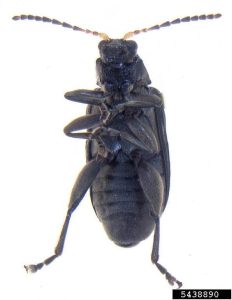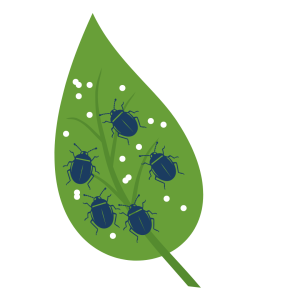
(Credit: Rodrigo Diaz, University of Florida, Bugwood.org)
The daytime call of birdsong heralds our gentle transition into the spring season. Light rainstorms ensure that our soils are saturated and that our plants are nourished. The sun’s rays work in tandem to encourage the emergence of fresh, lush, green leaves.
As the weather begins to bring life into our gardens, we may also start to see the rise of peckish pests looking to take advantage of this nutrient-rich, new growth. One common visitor to the garden during this time is none other than the small but mighty flea beetle.
Flea beetles have earned their namesake because of their ability to leap great lengths. This is due to their enlarged femur, or the upper part of their hindleg. Beyond their legendary legs, many species of flea beetle gather in groups when feeding.
While some are more generalist feeders, eating a wide variety of plants, others are more host-specific and will only eat certain plants. Keep reading to learn more about flea beetles and how to manage them in the home garden.
Flea Beetles (Tribe Alticini)
There are several species of flea beetle in Florida, belonging to the tribe Alticini, and only some are known pests. In this blog, we will cover a few of the common species you might encounter here in Florida.
Altica spp.


| Description: |
|
| Host plants: |
|
Shiny flea beetle (Asphaera lustrans)


| Description: | |
| Host plants: |
|
Alligatorweed flea beetle (Agasicles hygrophila)


| Description |
|
| Host plants |
|
Life Cycle

Like other beetles, flea beetles are holometabolous. This means that they have four distinct life stages, akin to butterflies. These stages include the egg, larva, pupa, and adult. Female flea beetles will often lay their eggs directly on plants or in the surrounding soil. The eggs are small and elliptical in shape, measuring an average of 1 to 2 mm in length. Depending on the species, the color may vary from white to yellowish grey.
Once hatched, the larva will feed on its host plant. Some species, such as the ones highlighted in this blog, feed on the leaves of their host plant. Other species feed on roots. When the larva consumes enough plant material to grow and reach its final instar, or immature life stage, it will pupate. This is its transitional stage between larva and adult. It will stay immobile until the time is right. Then, it will emerge from its hardened, pupal casing as an adult flea beetle! This process, from egg to adult, often takes up to one month.

Damage
Adult flea beetles feed on leaves. One telltale sign of flea beetle feeding is their leftover “shotholes,” which look like the aftermath of a spaghetti western shootout. Thankfully, the damage isn’t usually deadly. The sight is gruesome, nonetheless, and in some cases, if the infestation is severe enough, defoliation and subsequent plant death may occur. This is more common in younger plants with fewer leaves.
Management
As mentioned previously, not all flea beetles need to be managed. In fact, some are even beneficial, such as the alligatorweed flea beetle!
For those that do require management, there are a number of strategies that can be utilized. It is important to note that flea beetles are highly mobile and can easily jump off of plants when disturbed. This can make chemical spray treatments difficult.
Try the following tips to reduce flea beetle damage:
- Scouting is key! Regularly check your garden for the presence of flea beetles. Early detection can make a big difference.
- Remove debris, such as leaf litter, and any weeds that may host adult flea beetles.
- In the fall and winter, till your soil to uncover any flea beetles that may be in hiding.
- Plant several seedlings to spread the damage across plants. This will make it much more likely for some plants to survive.
- Use trap plantings to drive flea beetles away from desired plants in the garden.
- Consider push plantings in and around your beds to help repel flea beetles.
- Options include: catnip, sage, mint, hyssop, nasturtium, and basil
- Spray water on flea beetles to deter feeding.
- Consider purchasing nematodes or parasitic wasps to help control existing populations of flea beetles.
- Make sure to read the product description before buying to see which species it helps control.
- Applying a light layer of talcum powder or kaolin clay to leaves creates a barrier to discourage flea beetle feeding.
- If you have an active infestation, wear gloves and hand pick the beetles off your affected plants. They can then be placed in a container and sprayed with insecticidal soap, neem, or another insecticide.
- Always read the label before applying pesticides of any kind!
As with all suspected insect pests, it’s critical to properly identify the species before treating. If you’re unsure about an identification, consider reaching out to your local Extension office or making use of the University of Florida’s Insect ID Lab.
 Resources
Resources
The resources below were used as references for building this blog. They also provide great information for further learning!
- UF/IFAS Featured Creatures: Flea Beetles of the Genus Altica
- UF/IFAS Extension: The Fleeing Beetle
- University of Minnesota Extension: Flea Beetles
- Colorado State University Extension: Flea Beetles
- University of Madison-Wisconsin: Flea Beetles
- Purdue Extension Entomology: Flea Beetles
Source: UF/IFAS Pest Alert
Note: All images and contents are the property of UF/IFAS.



